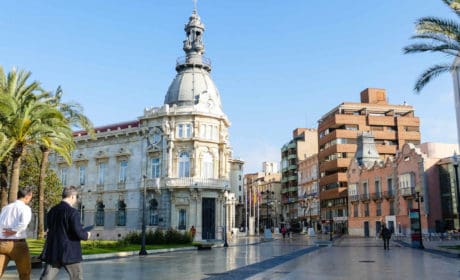From its traditional pueblos to bustling cities like Madrid and Barcelona, Spain is a favorite for travelers. However, those in the know, know that the country’s heart and soul can be found in Andalusia, and in Granada in particular.
Guest contributor, Kirsten Gallagher, shows us how to spend a unique weekend exploring Granada—a beautiful city with a vibrant history.
Exploring Granada: Looking for Flamenco in the Albaicín
Like its fruity namesake, exploring Granada (which means pomegranate in Spanish) is a delicious treat for travelers. Most tend to spend only a day or two in this historic treasure, just enough time to visit the Alhambra, a majestic and massive Moorish complex of palaces, gardens and luxurious living spaces dating back to the 11th century.

When I explored Granada, I wanted to visit the Alhambra, of course, but I was also intent on venturing beyond the city center to the Albaicín, an area where gypsies once lived in cave dwellings and crafted the dramatic dance for which Spain is now immensely famous: flamenco.
Boomer Travel Tip
Planning a trip to Spain? Our Spain Travel Planner will take you there.
A self-guided walking tour of the Albaicín

The Albaicín can be reached on foot by following Carrera del Darro, which starts at Plaza Nueva and runs along the river. Near the city center, Carrera Darro is thick with tourists pouring in and out of shops and outdoor cafes; it gradually thins out as you walk uphill away from the tourist strip.
Keep going until there’s no longer the option to go any further, then take a left to enter the Albaicín. From its hilltop location, the Albaicín gives you a glorious panoramic view of the Alhambra, which is worth the hike itself.

The streets of the Albaicín are like a game of Snakes n’ Ladders. As I wove my way up, down, backwards and forwards, through its sinuous streets and passageways, I heard the mournful plucking of guitarists and the unabashed belting of singers busking on street corners.
Boomer Travel Tip
Start your search for Granada hotels with us.
Discovering flamenco in Granada
The flamenco tradition is proudly on display throughout the Albaicín. There are numerous creaky tablaos offering flamenco shows (usually with two shows per night, with or without dinner), as well as markets, shops and cafes.
Just before venturing into Sacromonte, a sub-area of the Albaicín, I stopped briefly at Rincón de Chapíz (Calle Peso de la Harina 1), a delightful corner cafe with the best cafe cortado in town, where the staff helped me direct me to the (embarrassingly-nearby-but-somehow-still-hard-to-find) Museo Cuevas del Sacromonte.

The aptly-named Caves Museum is indeed a collection of caves, recreating the former living conditions of the gypsy population. Entry is €5 (approximately $5.70)
Outside each cave is a placard, detailing some aspect of gypsy life. Inside the caves, there are artifacts to help you imagine it—clothes, tools, blankets and other everyday items.
I spent a little more than an hour poking about, imagining what life would have been like living in a cave with so very little. Then, ironically and without compunction, I shook off the guilt from having so many modern-day luxuries and went to a spa.
Boomer Travel Tip
MedjetAssist Members who are hospitalized 150 miles from home receive medical transport to a home-country hospital of choice. Memberships from $99.
Luxuriating in the Arab Baths

Southern Spain is not only known for flamenco, but also for its baños arabes (literally translated, arab baths). Here you can relax after roaming your destination for several hours.
I had booked a session at Hammam Al-Andalus (Calle Santa Ana 16), which is not far from the aforementioned Plaza Nueva. I booked online well in advance because the spa is popular among tourists and locals alike.
Hammam Al-Andalus features a water circuit consisting of baths of varying temperatures, including a scalding hot (in a good way) bath and a freezing cold (also in a good way) bath. Bathers wade in and out of the baths which are housed in quiet rooms dimly lit by flickering candles.
I had to quell my natural tendency to chat with fellow travelers as the spa had a serene and meditative atmosphere that would have been disturbed by chit-chat. (Indeed, there are signs urging bathers to keep quiet, in the hopes that they will allow themselves to fully unwind while hearing nothing but the drops of water echoing in the stillness.)

I had also booked a half-hour massage, one of the many treatments available at Hammam Al-Andalus. After spending nearly two hours (which felt like no time at all) in the baths, the jacuzzi and the eucalyptus sauna, I was summoned for my massage.
Unlike other massages that I have had in the past, I stayed face-down the whole time as the massage therapists kneaded my calves, back and shoulders with vanilla massage oil, releasing the tension in my muscles that had accumulated over the course of the day. Lastly, I refreshed myself with several small cups of mint tea outside the massage area before reluctantly calling it a day.
The traveler to Europe often remarks how much walking there is to do. That is certainly true when exploring Granada, Spain. If you’re there to see the Alhambra or meander through the Albaicín, at the end of your day you’ll no doubt want to treat yourself to a few tranquil hours at one of its baños arabes.
Save to Pinterest




